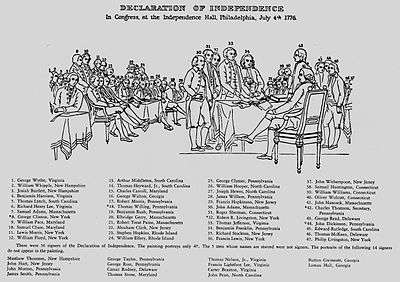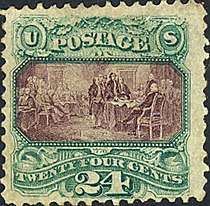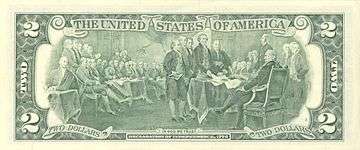Declaration of Independence (Trumbull)
Declaration of Independence is a 12-by-18-foot (3.7 by 5.5 m) oil-on-canvas painting by American John Trumbull depicting the presentation of the draft of the Declaration of Independence to Congress. It was based on a much smaller version of the same scene, presently held by the Yale University Art Gallery.[1] Trumbull painted many of the figures in the picture from life, and visited Independence Hall to depict the chamber where the Second Continental Congress met. The oil-on-canvas work was commissioned in 1817, purchased in 1819, and placed in the United States Capitol rotunda in 1826.
| Declaration of Independence | |
|---|---|
%2C_by_John_Trumbull.jpg) | |
| Artist | John Trumbull |
| Year | commissioned 1817; purchased 1819; date of creation 1818; 1826 placed in the Rotunda |
| Medium | Oil-on-canvas |
| Dimensions | 3.7 m × 5.5 m (12 ft × 18 ft) |
| Location | U.S. Capitol, Washington, D.C., U.S. |
The painting is sometimes incorrectly described as the signing of the Declaration of Independence. The painting shows the five-man drafting committee presenting their draft of the Declaration to the Congress, an event that took place on June 28, 1776, and not the signing of the document, which took place later.[2]
The painting shows 42 of the 56 signers of the Declaration; Trumbull originally intended to include all 56 signers but was unable to obtain likenesses for all of them. He also depicted several participants in the debate who did not sign the document, including John Dickinson, who declined to sign. Trumbull had no portrait of Benjamin Harrison V to work with, but his son Benjamin Harrison VI was said to resemble his father, so Trumbull painted him instead. As the Declaration was debated and signed over a period of time when membership in Congress changed, the men featured in the painting never were in the same room at the same time.
In the painting, Thomas Jefferson appears to be stepping on John Adams' foot, which many thought was supposed to symbolize their relationship as friendly rivals. However, upon closer examination of the painting, it can be seen that their feet are merely close together. This part of the image was correctly depicted on the two-dollar bill version.
Three British ensigns and a single English ensign can be seen hanging on the farthest wall in the painting, though this is not depicted in all versions, most notably the one seen on the two-dollar bill.
Key to historical figures depicted in the painting
%2C_by_John_Trumbull.jpg)
Click anywhere else in the image to go to the image's file page and view a larger version.

The following key to the 47 figures in the painting follows the numbering used by the U.S. government publication "Art of the Capitol" (in the illustration of the key shown in this section) but provides a different (hopefully clearer) description of which figure is where in the painting, so numbers are not entirely in order.
Key to figures (in each group, listed from left to right):
Four men seated on the far left:
- 1. George Wythe
- 2. William Whipple
- 3. Josiah Bartlett
- 5. Thomas Lynch, Jr.
Seated at the table on the left:
Seated together to the right of Harrison and in front of the standing figures:
- 6. Richard Henry Lee
- 7. Samuel Adams
- 8. George Clinton

Five figures standing together on the left:
- 9. William Paca
- 10. Samuel Chase
- 11. Lewis Morris
- 12. William Floyd
- 13. Arthur Middleton
Three seated figures in the back between the two sets of standing figures:
- 14. Thomas Heyward, Jr.
- 15. Charles Carroll
- 16. George Walton
Set of three figures standing together in the back:
- 23. Stephen Hopkins (wearing a hat)
- 24. William Ellery
- 25. George Clymer
Ten figures seated:
- 17. Robert Morris (first on the left at the table)
- 18. Thomas Willing

- 19. Benjamin Rush
- 20. Elbridge Gerry
- 21. Robert Treat Paine
- 22. Abraham Clark
- 26. William Hooper
- 27. Joseph Hewes
- 28. James Wilson
- 29. Francis Hopkinson
Five figures standing in front (the Committee of Five):
- 30. John Adams
- 31. Roger Sherman
- 32. Robert R. Livingston

- 33. Thomas Jefferson
- 34. Benjamin Franklin
Four background figures seated together near the right corner of the room:
- 35. Richard Stockton
- 36. Francis Lewis
- 37. John Witherspoon
- 38. Samuel Huntington
Two figures standing in the right corner of the room:
- 39. William Williams
- 40. Oliver Wolcott
Two foreground figures at the central table:
- 42. Charles Thomson (standing)

- 41. John Hancock (seated)
Three figures standing at right:
- 43. George Read
- 44. John Dickinson

- 45. Edward Rutledge
Two figures seated at far right:
- 46. Thomas McKean
- 47. Philip Livingston
(Note: ![]()
Unpainted signers
There were 14 signers of the Declaration who did not appear in the painting:
- Matthew Thornton (New Hampshire)
- John Hart (New Jersey)
- John Morton (Pennsylvania)
- James Smith (Pennsylvania)
- George Taylor (Pennsylvania)
- George Ross (Pennsylvania)
- Caesar Rodney (Delaware)
- Thomas Stone (Maryland)
- Thomas Nelson, Jr. (Virginia)
- Francis Lightfoot Lee (Virginia)
- Carter Braxton (Virginia)
- John Penn (North Carolina)
- Button Gwinnett (Georgia)
- Lyman Hall (Georgia)
On U.S. currency and postage stamps

Trumbull's Declaration of Independence signing scene painting has been depicted several times on United States currency and postage stamps. It was first used on the reverse side of the $100 National Bank Note that was issued in 1863.[3] The depiction was engraved by Frederick Girsch of the American Bank Note Company.[4] The same steel engraving was used on the 24¢ stamp issued six years later as part of the 1869 pictorial series of definitive U.S. postage stamps.[5]
Trumbull's painting is presently depicted on the reverse of the two-dollar bill. Featured in it are 40 of the 47 figures from Trumbull's painting. Cut out from the scene are: the farthest four figures on the left—George Wythe, William Whipple, Josiah Bartlett, and Thomas Lynch, Jr.; the farthest two figures on the right—Thomas McKean and Philip Livingston; and one of three figures seated in the left rear—George Walton. Additionally, two unrecognized figures were added: one in between Samuel Chase and Lewis Morris and another between James Wilson and Francis Hopkinson, bringing the total number of figures shown in this presentation scene to 42.
.jpg)

Other versions

Trumbull painted a smaller version (only 20.875 by 31 inches (53.02 cm × 78.74 cm)) entitled The Declaration of Independence, July 4, 1776 (1786–1820) that is now on view at the Yale University Art Gallery in New Haven, Connecticut.[1]
Legacy and interpretations
In 2017, the company Ancestry.com restaged the painting with the 29 living descendants of the men depicted in Trumbull's painting as part of an advertising campaign called “Declaration Descendants". [6][7] The campaign included two short films and ran on digital and social media platforms. Shannon Lanier, the sixth great-grandson of Thomas Jefferson, said: “When you see the new picture, the new image, it’s a picture of diverse people. Black, white, Hispanic, Native American—a little bit of everything—Asian, and that’s more of a representation of this country". [8]
In September 2019 Arlen Parsa, a filmmaker from Chicago, published an image of the painting with red dots covering the faces of those that enslaved people to his twitter account.[note 1] Parsa's research identified 34 of the 47 men depicted as slave holders, this was fact-checked by PolitiFact who rated the statement as "true". PolitiFact stated "We found strong evidence to back the claim on the 34, recognizing there is no one definitive source on the question."[9]
The 34 men depicted who were enslavers are:
- Josiah Bartlett
- Charles Carroll
- Samuel Chase
- Abraham Clark
- George Clinton
- John Dickinson
- William Floyd
- Benjamin Franklin
- John Hancock
- Benjamin Harrison
- Joseph Hewes
- Thomas Heyward Jr.
- William Hooper
- Stephen Hopkins
- Francis Hopkinson
- Thomas Jefferson
- Richard Henry Lee
- Francis Lewis
- Philip Livingston
- Robert R. Livingston
- Thomas Lynch
- Arthur Middleton
- Lewis Morris
- Robert Morris
- William Paca
- George Read
- Benjamin Rush
- Edward Rutledge
- Richard Stockton
- William Whipple
- Thomas Willing
- John Witherspoon
- Oliver Wolcott
- George Wythe
See also
- Congress Voting Independence, a similar painting by Robert Edge Pine, 1784-1788
- Declaration of Independence Tablet, Boston Common
- Scene at the Signing of the Constitution of the United States – a 1940 painting depicting members of the 1787 Constitutional Convention by Howard Chandler Christy.
- Syng inkstand, pictured in the painting
Notes
- Parsa, Arlen [@arlenparsa] (1 September 2019). "This is one of the most famous paintings in American history: Declaration of Independence. I decided to put red dots on all the men who held slaves.Next time someone puts them on a pedestal and says we can't question their judgement on guns or whatever, show them this image." (Tweet). Archived from the original on 6 July 2020.
References
- Trumbull, John. "The Declaration of Independence, July 4, 1776". Yale University Art Gallery.
- John Hazelton, "The Historical Value of Trumbull's - 'Declaration of Independence' ", The Pennsylvania Magazine of History and Biography - Volume 31, (Historical Society of Pennsylvania, 1907), 38.
- "History Timeline". Bureau of Engraving and Printing/Treasury Website. Archived from the original on 2014-01-14. Cite journal requires
|journal=(help) - Hessler, Gene (1993). The Engraver's Line – An Encyclopedia of Paper Money & Postage Stamp Art. BNR Press. p. 137. ISBN 0-931960-36-3.
- Forster, Jeffrey (2012). "The Chronicle's Assistant Section Editor - 1869 Pictorial Issue". U.S. Philatelic Classics Society. Archived from the original on May 14, 2011. Retrieved November 3, 2015.
- "'Declaration of Independence' Painting Recreated With Founders' Diverse Descendants". Observer. 2017-07-05. Retrieved 2020-07-05.
- Team, Editorial. "Meet the Descendants of America's Founding Fathers". Branding.news. Retrieved 2020-07-05.
- Quijao, Elaine (4 July 2017). "Founding Fathers' descendants unite 241 years later to re-create iconic painting". www.cbsnews.com. Retrieved 2020-07-05.
- Kertscher, Tom (2019-09-10). "Fact-check: They signed the Declaration of Independence — but nearly three-quarters also owned slaves". Chicago Sun-Times. Retrieved 2020-07-05.
External links
- Keys to the figures
- Other
- A web page with some information on the painting
- Architect of the Capitol Web page on the painting